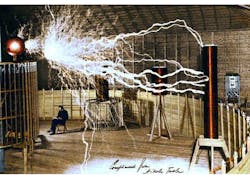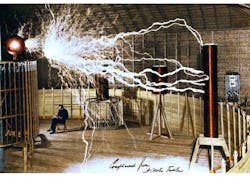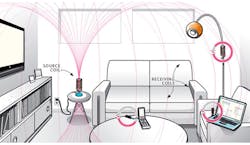Why Were The “Prisoners” Discussing Wireless Charging?
Detainees at Prison St. Michel, Nuremberg, recently got into a discussion about wireless charging. You may think this strange. But these detainees were, in fact, dinner guests at a restaurant of that name, which originally was a medieval prison.
The event was an informal industry dinner that Electronic Design Europe hosted during the PCIM Europe 2014 power electronics conference and show in that city. Conversations around the table ranged from costs involved in restoring an XK140 vintage Jaguar to whether or not wireless charging will be the next killer app.
Broadly speaking, the assembled “inmates” agreed on the €80k cost of a Concours d’Elegance restoration of an XK140. Around the table, though, speculation about the value of the wireless charging market was a touch conjectural.
On The Market
Industry analysts’ predictions for the value of the wireless charging market are notably less tentative. Some bullish estimates expect the global wireless charging market to rise to €5.3 billion in 2017 from €337 million in 2011 at an estimated compound annual growth rate (CAGR) of 57.5% from 2012 to 2017.
The scale of those figures would have bemused Nikola Tesla. He introduced the concept of wireless charging in 1891 when he demonstrated wireless energy transmission by means of electrostatic induction using a high-tension induction coil (Fig. 1).
Today, wireless chargers are supplied in a variety of guises. But they are still based on electromagnetic coupling, whereby electromagnetic fields enable charging. Currently, there are five wireless technologies: inductive coupling, RF, magnetic resonance, microwave, and optical beam technology.
But like all burgeoning technologies, the commercial progress of the wireless charging market is impeded by the absence of standards necessary to ensure compatibility between different providers and their equipment. Fundamentally, consumers tend to feel more confident about parting with their cash when they know the equipment they are buying will not be rendered useless by incompatibility problems.
On a more positive note, the embryonic wireless charging industry has numerous consumer-related application opportunities that it can exploit, such as wireless charging facilities in restaurants, cinemas, railway stations, airports, and many public areas.
Industry pundits believe the increased use of wireless charging technologies by consumers during the next three years could result in a globally installed user base approaching 140 million units.
So, a speedy and pragmatic finalization of industry standards that will allay consumers’ compatibility concerns is an indisputable imperative. Now, three standardization bodies are striving to take a leading position in the wireless charging market.
The Organizations
With 180 industry members, the Wireless Power Consortium (WPC) has established the Qi standard. Approximately 380 products are certified as conforming to the globally recognized standard.
Formed in 2012, the Power Matters Alliance (PMA) has about 100 members and is now formalizing its industry standard. The Alliance for Wireless Power (A4WP), also founded in 2012, has 60 members. The first products that meet this standard are expected in 2014.
Standards battles are inevitable when it comes to emerging technologies, as demonstrated by the Betamax/VHS and Blu-ray/HD-DVD conflicts. Predicting which standard will ultimately win at this stage of development is tricky because each standard organization is concentrating on different technological approaches.
The WPC and PMA standards are based on inductive charging, so they are defined as tightly coupled systems and are recognized as more efficient than the alternative loosely coupled approach, which employs resonant charging. But as the name suggests, the receiver and transmitter must be within a few millimetres of each other in tightly coupled charging.
The Alliance for Wireless Power supports resonance charging, which allows greater freedom in how units that need charging have to be positioned against the charging transmitter unit. It permits more spatial variety and could enable numerous devices to be placed on a charging pad simultaneously (Fig. 2).
However, there is a downside to loosely coupled charging. That spatial freedom depletes efficiency, and electromagnetic interference (EMI) issues must be addressed.
Reduced efficiency is particularly important when it comes to wireless charging. It would mean longer charging times and could exacerbate heat dissipation problems, two things that would alienate consumers.
Tightly coupled charging provides efficiencies higher than 70%, whereas loosely coupled charging performs at 60%.
System safety is another prime concern. All wireless charging systems will have to be able to recognize foreign objects to avoid heating metal-based objects that are inadvertently positioned on the power transmitter. Foreign object detection, then, is an essential design element.
Communication between the transmitter and receiver needs to ensure that the level of power transfer is well controlled and that any exceptional power losses are detected. Indeed, without tried and tested communication systems, wireless charging will neither start reliably nor be maintained consistently.
Emerging standards from the various industry bodies not only need to define the myriads of electrical and electronics specifications required for wireless charging compatibility, they also need to formalize and implement precise and sustainable communication and safety criteria.
About the Author
Paul Whytock Blog
European Editor
Paul Whytock is European Editor for Penton Media's Electronics Division. From his base in London, England, he covers press conferences and industry events throughout the EU for Penton publications and its Engineering TV and Radio services Qualified to HNC Full Technological Certificate standard, Whytock trained as an automotive design engineer with Ford Motor Company prior to entering technical journalism.


